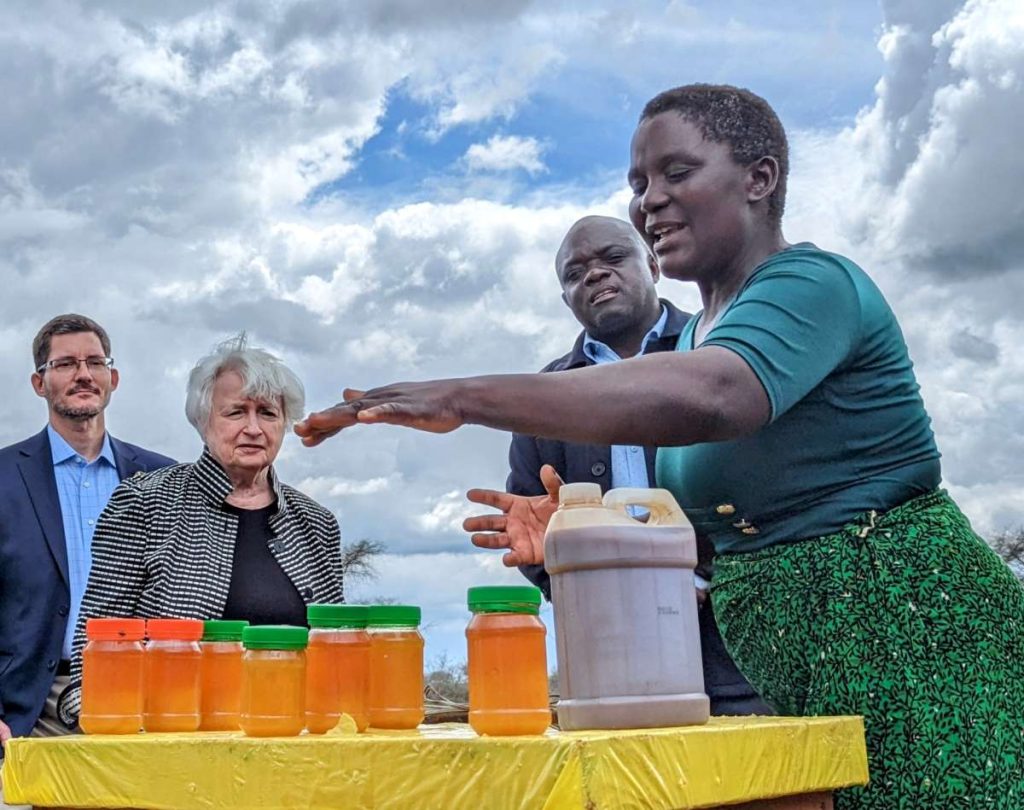Zambia like other indebted and capital deficient countries of Africa needs desperately funds to develop its infrastructure to connect its mineral rich areas to the big cities and ports … writes Kaliph Anaz. Zambia owes over $6 billion to China now. The Communist country , under its Belt and Road Initiative (BRI) is helping many countries like Zambia to build infrastructure in Africa, the final result nevertheless, is eventually creating a debt burden on these countries and compelling them to sell their natural resources at cheaper prices to mobilize funds for debt repayment.
Zambia is facing an unsustainable debt burden and debt servicing is leaving little for capital formation, especially funds required for infrastructure development. While the country is struggling to carry out World bank suggested reforms measures, including restoring fiscal and long-term debt sustainability, increasing farmer productivity and access to agricultural markets, ensuring access to energy and access to finance and private sector development, it is facing a paucity of resources and it makes the country dependent on and vulnerable to external debt.
In view of this, the Zambian government is actively seeking further infrastructure development through Public-private Partnership (PPP) projects. Zambia like other indebted and capital-deficient countries of Africa needs desperately funds to develop its infrastructure to connect its mineral-rich areas to the big cities and ports.
Zambia is under a heavy debt burden and the post-Covid economic recovery is sluggish. In such a situation it could not upgrade the dilapidated road from its mining sites to the export destinations due to a lack of funds to build infrastructure. China, which has a keen interest in African countries’ natural resources, takes such desperation among the African countries as an opportunity to create dependence on these countries on China and have control of their natural resources. Although China, under its Belt and Road Initiative (BRI) is helping many countries to build infrastructure in Africa, the final result nevertheless, is eventually creating a debt burden on these countries and compelling them to sell their natural resources at cheaper prices to mobilize funds for debt repayment.

Recently, a consortium of Chinese companies has won a bid to finance the upgrading of a 327 km road linking the Zambian capital Lusaka to Ndola, in the country’s Copperbelt province. The Consortium Macro Ocean Investment won the bid which consists of three Chinese companies, viz., AVIC International Project Engineering, Zhenjiang Communications Construction Group and China Railway Seventh Group. The consortium won the USD 650 million deal to build the dual carriageway road under the public–private partnership (PPP) model. The agreement signed by the Chinese companies last month gave them a 25-year concession period, split into three years for construction and 22 years of operation and maintenance rights.
The road awarded to the Macro Ocean Investment consortium links the Zambian capital to the mineral-rich Copperbelt province and the border with the Democratic Republic of Congo (DRC) and carries almost all the road-bound mineral exports from the region along the southern corridor towards Tanzania.
However, there is a murmur among the critics of the Zambian government for its dependence on China for building infrastructure. The concern expressed by them pertains to the fact that China is the single biggest lender to Zambia and now as a country is facing an unsustainable debt burden, additional Chinese loans at almost commercial rates would further aggravate the problem. Its loan accounted for more than USD 6 billion of the country’s total USD 16.8 billion as of December 2021.
The debt burden and macro-economic situation of Zambia deteriorated rapidly in the post Covid-19 period. It was compelled to seek support from the World Bank. On December 20, 2022, the multilateral financial institution announced the release of the second tranche of its support for the Zambia Macroeconomic Stability, Growth and Competitiveness Programme- a USD 100 million concessional credit as part of USD 275 million concessional development policy financing for Zambia in October 2022 in support of Zambia’s reforms to restore fiscal and debt sustainability and promote private sector-led growth.

Although the Zambian economy rebounded in 2021, with GDP growing at 4.6%, from a contraction of 2.8% during the pandemic in 2020 the projection for next two years declined. In 2022-24 Zambia’s GDP is projected by the World Bank to grow by an average rate of 3.8%, but the projection is anchored in the government’s implementation of macroeconomic reforms.
The economic reforms could make things difficult at least in the short- term due to belt-tightening and austerity policy to contain fiscal deficit as well as rising inflation. Zambia’s economic performance has stalled in recent years due to declining copper prices, significant fiscal deficits, and energy shortage. Rising inflation is pushing people into poverty and making life difficult. Inflation rose to 17.4% in 2020 and is hovering in the range of 6-8% since then, according to the African Development Bank Group (ADBG). The group in its assessment has also pointed towards increasing fiscal deficit which has fluctuated in the range of 8-11% of GDP due to expansionary fiscal policy, mainly financed by external and local borrowings. This pushed up the publicly guaranteed debt of Zambia to 91.6% of GDP in 2019 and 105% in 2020. It also forecasts that the debt-GDP ratio would remain elevated in the medium term.
ADBG is not upbeat like the World Bank about the growth prospects of Zambia. The ADBG in its African Economic Outlook 2022 projected a very modest growth rate for Zambia – 1.0% in 2021 and 2% in 2022. It also forecasted job losses in the services sector (on average 30.6%), manufacturing (39%), personal services (39%) and tourism (70%). The projected picture of growth is not so heartening. However, people voted for a new government in the hope that economic reforms and debt management would be carried out better by the new leadership.
The new President of Zambia Hakaind Hichilkma came to power in 2021 by promising a higher growth rate of around 10% and bringing the country out of its USD 12.8 billion debt mess (estimated then) within five years. Youth who were a major component of his landslide victory against the incumbent Edgar Lungu was driven by unemployment, political disenchantment and economic hardship. But it was neither an easy task in the past nor is it today.
Dealing with larger economic issues would require austerity measures that will further put an additional economic burden on already suffering people due to unemployment and inflation. The IMF conditionality, which Zambia is committed to implementing for the support it is getting from the multilateral institution, would be politically unpopular. These measures would include rolling back subsidies in electricity and petrol prices as well as reconfiguring the civil services wage bill.
In the present situation seeking additional funds for infrastructure development from foreign countries and especially China is being seen by many observers as a sure recipe for peril as the latter provides funding at higher and commercial rates. Many of them are afraid of a repeat of what happened in Sri Lanka last year and now happening in Pakistan this yer due to reliance on foreign debt. Zambia may be pushed into a default-like situation and saturating economic crisis if does not maintain balance and caution in infrastructure development.
Zambia has understood that infrastructure development is very important for development. It’s implementing the Link Zambia project, which seeks to transform the country from land-locked to land-licked. The project involves paving 8,201 km of the road at an estimated cost of USD 5.6 billion. The country is also expanding the collection of road tolls on major roads to fund road maintenance and broaden financing options for road infrastructure development, such as the Pave Zambia 2000 program, which is aimed at the rehabilitation of 2000 km of urban roads; and the L400 project, which is constructing or rehabilitating 400 km of Lusaka urban roads at a cost of USD 348 million.
Infrastructure development and industrialization is no doubt very important for Zambia for self-reliant and sustainable growth. But in this bid, there is a danger of Zambia falling into a vicious cycle of debt and its repayment, especially since the Chinese debts are accumulating and posing servicing burdens on the financially weak country.
According to a Press release at the time of its offer of the second tranche of the World Bank’s support for the Macroeconomic stability, Growth and Competitiveness Programme, Zambia is in debt distress and urgently needs deep and comprehensive debt treatment in line with the Joint WB- IMF Debt Sustainability Analysis (DSA) that called for USD 8.4 billion in debt relief in 2022-25 period and additional relief through 2031.
In such a situation Zambia needs to be cautious about any new external borrowing. Rather it should seek relief from its largest creditor, i.e. China. Besides, bargaining external funds in lieu of its natural resources is not good for the future development of the country. It would always be better for Zambia to develop and diversify its own industries and gradually try to be self-reliant. It is believed that if Zambia carries out economic reforms as suggested by the multilateral financial institutions, it would have more access to concessional funds from them and it would draw more investment.

